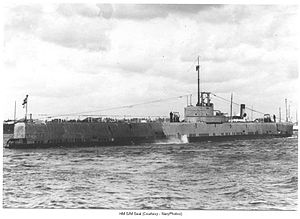HMS Seal (N37)

HMS Seal in 1939
|
|
| History | |
|---|---|
|
|
|
| Name: | HMS Seal |
| Builder: | Chatham Dockyard |
| Laid down: | 9 December 1936 |
| Launched: | 27 September 1938 |
| Commissioned: | 24 May 1939 |
| Captured: | Nazi Germany, 5 May 1940 |
| Badge: | |
|
|
|
| Name: | UB |
| Acquired: | 5 May 1940 |
| Commissioned: | 30 November 1940 |
| Decommissioned: | 31 July 1941 |
| Fate: | Scuttled 3 May 1945 at 54°22′N 10°11′E / 54.367°N 10.183°ECoordinates: 54°22′N 10°11′E / 54.367°N 10.183°E |
| General characteristics | |
| Class and type: | Grampus-class submarine |
| Displacement: |
|
| Length: | 293 ft (89.31 m) o/a |
| Beam: | 25 ft 6 in (7.77 m) |
| Draught: | 16 ft 10 in (5.13 m) |
| Propulsion: |
|
| Speed: |
|
| Range: | 6,500 nautical miles (12,000 km; 7,500 mi) at 10 knots (19 km/h; 12 mph) |
| Test depth: | 200 ft (61 m) |
| Complement: |
|
| Armament: |
|
HMS Seal was one of six ships of the Grampus-class mine-laying submarines of the Royal Navy. She served in the Second World War and was captured by the Kriegsmarine and taken into German service as UB. She was the only submarine the Germans captured at sea during World War II. Her capture allowed the Germans to correct a critical fault in their U-boat torpedoes.
Seal was laid down at the Chatham Dockyard on 9 December 1936, launched on 27 September 1938 and commissioned into the Royal Navy on 24 May 1939. During her entire British career, her commander was Rupert Lonsdale, for whom it was his second command.
On being commissioned, Seal went for acceptance trials at Dartmouth and in Tor Bay. On the day of her first successful deep dive, 1 June 1939, news arrived of the loss of HMS Thetis undergoing trials at Liverpool, a personal setback for the crew who had lost many friends. Seal moved to Gosport to complete torpedo trials.
On 4 August, she sailed to China to join HMS Grampus and Rorqual via Gibraltar, Malta and the Suez Canal. However, on the outbreak of the Second World War, she was detained at Aden and made two ad hoc patrols watching the Italians, whom it was feared might be towing German submarines while Italy was still not at war. She returned home, escorting a damaged destroyer in the Mediterranean. Back in the North Sea, she carried out one patrol near the Dogger Bank and received her first attack from German aircraft. She then augmented a convoy escort to Halifax, Nova Scotia, a 14-day crossing. She was back in time for Christmas leave and was based at Elfin, a temporary establishment at Blyth, Northumberland. She settled to a North Sea patrol routine as part of the Norwegian campaign being based at Rosyth. One night in February, Seal was given an extra set of personnel – an armed boarding party – and was assigned to take part in the hunt for the German tanker Altmark. However Seal played no part in the Altmark incident. Admiral Horton met Seal on one of her returns to Rosyth and commented, "You're too damn clean for a war-time boat. Something must be wrong". However, he revised his opinion when he reviewed the log-books to "you must have a damn good crew".
...
Wikipedia

